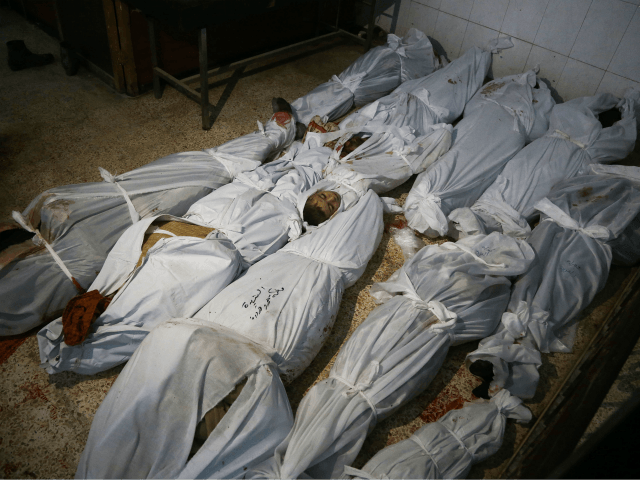The Syrian Observatory for Human Rights (SOHR), a non-governmental organization, revealed this week that it had confirmed the deaths of nearly 500,000 people during the decade-long Syrian civil war.
The SOHR explained in its report on Monday that it estimated the true death toll to be over 606,000 people, but that it had independently confirmed 494,438 people killed between March 15, 2011, and May 30, 2021.
The Syrian Civil War began in 2011 as a popular uprising against dictator Bashar al-Assad. Assad, with help from allies in Iran and Russia, rapidly began a violent crackdown on protesters and civil society groups that featured widespread evidence of the use of chemical weapons against civilians. Assad has denied the allegations, accusing rebel groups of using chemical attacks but not the Syrian Arab Army.
The SOHR documented 105,015 deaths over the past six months, adding to its tally and reaching nearly half a million people since the war began. Civilians constituted the largest group of people killed throughout the war, although the SOHR identified 11 groups of fighters of all stripes affected. Assad’s army lost slightly over 90,000 people while rebel fighters and Islamist factions lost nearly 80,000 people, rounding out the top three death toll categories:
• Civilians: 159,774 Syrians, they were: 119,591 men, 25,048 children under the age of eighteen and 15,135 women over the age of eighteen
• Syrian fighters of rebel and Islamic factions and other various factions, movements, and organizations: 79,844
• Syria Democratic Forces (SDF) and Kurdish units: 12,926
• Regime army defectors: 3,588
• Bashar al-Assad’s regime forces: 91,031
• National Defence Forces (NDF) fighters and Syrian regime loyalists: 66,995
• Lebanese Hezbollah: 1,707
• Non-Syrian militiamen loyal to the regime forces of the Shiite community: 8,593, of whom there were 264 were Russian soldiers and mercenaries
• Turkish soldiers: 215
• Jihadists of Hayyat Tahrir Al-Sham (former Nusra Front), and other jihadi organizations: 27,765
• ISIS members: 40,628
• Non-Syrian fighters of SDF: 936
Missing from this death toll are those killed fighting for the U.S.-led coalition against the Islamic State “due to the extreme secrecy shrouding their missions and operations.” Another 436 deaths are not part of the official death toll because to SOHR could not confirm their identities, the group said.
In addition to the deaths, the SOHR estimated over 2 million injured in the war and 13 million refugees.
Fighting between Assad and rebel groups escalated into a war featuring, at its peak, as many as ten different warring factions. The rebel groups attracted support from jihadist organizations like al-Qaeda and its formerly affiliated Nusra Front. During the span of the war, al-Qaeda in Iraq broke off from its parent organization and became the Islamic State of Iraq and Syria (ISIS), establishing a jihadist “caliphate” with its capital in the city of Raqqa. Christians, Turkmen, and other minority groups organized militias in an attempt to defend themselves from ISIS’s genocidal campaigns.
The Syrian People’s Protection Units (YPG/YPJ), Kurdish militias attempted to establish a sovereign state, became involved and played a primary role in the war against ISIS, which Assad largely avoided participating in. Turkish President Recep Tayyip Erdogan also invaded Syria, allegedly to “end the rule of the tyrant Assad,” but has since embarked on a campaign in Syrian Kurdistan to repopulate the areas with Arabs, which Kurds have decried as ethnic cleansing.
As of 2021, the original anti-Assad rebel movement has largely faded and the Islamic State exists only in pockets of territory in between sites controlled by Damascus and those maintained by the Kurds, granting Assad control of most non-Kurdish territory. Assad organized a “presidential election” last week in which he banned most candidates and most potential voters either boycotted or had no access to ballots; he “won” with 95 percent of the vote.
Assad personally voted in the election in the city of Douma, one of the sites made notorious through a regime-led chemical weapons attack. Assad reportedly attacked Douma with chemical weapons in 2018. The World Health Organization (W.H.O.) documented over 70 killed and another 500 presenting severe symptoms of chemical weapons poisoning, demanding an end to Assad’s violations of human rights and laws of war.
The W.H.O. granted Assad’s government a seat on its executive board on Monday.
“This election rewards the Assad regime despite its systematic destruction of hospitals and health centers, in addition to a long list of other war crimes and violations of international humanitarian law targeting civilians, aid workers and medical personnel over the past decade,” a Syrian Civil Defense, a group commonly known as the “White Helmets” who have conducted first aid responses to several suspected chemical weapons attacks, said in a statement this week. “We firmly condemn the election of a Syria led by Assad to the WHO Executive Council, just as we refuse to betray our fellow humanitarian workers and the victims of the Assad regime’s attacks.”
The United Nations, the W.H.O.’s parent organization, warned last week that Syria was experiencing “growing humanitarian suffering” even as direct military clashes have diminished in frequency.
“It is a tragic irony that this time of relative calm, compared with earlier years of the conflict, is also a period of immense and growing humanitarian suffering of the Syrian people,” U.N. special envoy to Syria Geir O. Pedersen warned.

COMMENTS
Please let us know if you're having issues with commenting.